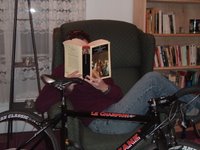As Nicholson Baker nears the end of his novel The Mezzanine, his narrator begins talking about Marcus Aurelius's Meditations. We learn he has begun to read this book because of "a glowing mention in William Edward Hartpole Lecky's History of European Morals (which I had been attracted to, browsing in the library one Saturday, by the ambitious title and the luxurious incidentalism of the footnotes)." And here Baker inserts a footnote. This footnote starts off with anecdotes from Lecky's book and modulates into a discussion of footnotes themselves. This is the sentence with which the footnote ends: Digression -- a movement away from the gradus, or upward escalation, of the argument -- is sometimes the only way to be thorough, and footnotes are the only form of graphic digression sanctioned by centuries of typesetters. And yet the MLA Style Sheet I owned in college warned against lengthy, "essay-like" footnotes. Were they nuts? Where is scholarship going? (They have removed this blemish in later editions.)Footnotes are the finer-suckered surfaces that allow tentacular paragraphs to hold fast to the wider reality of the library.
I'm not entirely sure if that's a brilliant sentence or a terrible one. Maybe it's brilliant in its awfulness. But I love the idea that footnotes connect the book to the rest of the library, to a wider reality.
But back to the beginning -- Baker's narrator repeats a couple of the anecdotes from Lecky's book, one of which tells us that Spinoza "liked to entertain himself by dropping flies into spiders' webs, enjoying the resultant battle so much that he occasionally burst out laughing." The narrator considers why such side notes, such digressions are so much fun, and in doing so, he quotes Boswell on Samuel Johnson:Upon this tour, when journeying, he [Johnson] wore boots, and a very wide brown cloth great coat, with pockets which might have almost held the two volumes of his folio dictionary; and he carried in his hand a large English oak stick. Let me not be censured for mentioning such minute particulars. Everything relative to so great a man is worth observing.
The narrator goes on, and here we get to the heart of his footnote on footnotes:Boswell, like Lecky (to get back to the point of this footnote), and Gibbon before him, loved footnotes. They knew that the outer surface of truth is not smooth, welling and gathering from paragraph to shapely paragraph, but is encrusted with a tough protective bark of citations, quotation marks, italics, and foreign languages, a whole variorum crust of "ibid.s's" and "compare's" and "see's" that are the shield for the pure flow of argument as it lives for a moment in one's mind. They knew the anticipatory pleasure of sensing with peripheral vision, as they turned the page, a gray silt of further example and qualification waiting in tiny type at the bottom.
At the risk of boring you, here's a bit more:
This whole book is an illustration of what Baker means by "luxurious incidentalism"; we find this in his footnotes, but we also find it in the text itself, which wanders from topic to topic as the narrator's mind wanders on his lunch break. I begin to wonder, not how Baker could write 135 pages about one morning, but how he could capture the whole morning in a mere 135 pages.
Footnotes on one's own thinking interest me. How does one decide what belongs in the main text and what belongs in a footnote, especially when the main text is itself already very digressive? To footnote someone else's text I understand, and to footnote one's own scholarly work with further details and explanations and documentations I understand, but to footnote a record of one's own thoughts, a record that is by no means smooth and sequential to begin with and is already full of footnote-like digressions -- that shows just how complicated it is to try to capture what goes on in a mind. If the "outer surface of truth is not smooth, welling and gathering from paragraph to shapely paragraph," then neither is the "outer surface" of the mind.
I'm curious about this because the book ends with two endings, two climaxes, one in the main text and one in a footnote. The ending in the main text is quite simple: the narrator makes it to the top of the escalator. The footnote ending is about the resolution of the shoelace dilemma (what, exactly, wears them down and causes them to snap?) After researching the question exhaustively, the narrator finds a 1984 volume of World Textile Abstracts, with the following entry by the Polish researcher Z. Czaplicki:
Two mechanical devices for testing the abrasion resistance and knot slippage performance of shoe laces are described and investigated. Polish standards are discussed.
Here is the narrator's response:
I let out a small cry and slapped by hand down on the page. The joy I felt maybe difficult for some to understand. Here was a man, Z. Czaplicki, who had to know! He was not going to abandon the problem with some sigh about complexity and human limitation after a minute's thought, as I had, and go to lunch -- he was going to make the problem his life's work ... A great man! I left the library relieved. Progress was being made. Someone was looking into the problem. Mr. Czaplicki, in Poland, would take it from there.
He doesn't discover what makes shoelaces wear out, but there is somebody out there just as fascinated by the question as he is. The footnote ending shadows the main text ending, but in a way it is more important than the main text ending. The footnote ending points the reader out of the novel, out of the narrator's mind, out to the world; it is an example of those "finer-suckered surfaces that allow tentacular paragraphs to hold fast to the wider reality of the library."



|